Training Hex Offence with your team
updated 03/10/2018 | old version available in French / en Français
Hex is a new offence which most of your team will not have seen or played before – introducing it can be both fun and exciting, but will certainly come with its challenges. I’ve had experience introducing the offence to a variety of teams and players, from primary schools through University level teams, at Hex Clinics and GB U23s, and along the way have learned plenty about how to make the introduction as enjoyable and productive as possible. I hope to share some of what I’ve learnt with you in this article.

If your team are already committed to learning Hex, you can arrange for a Hex Clinic to be run in your city – this includes a classroom session to go over the Hex documentation, video examples, shape & movement theory aspects of the offence, and immediate analysis of footage from the training. This will set your whole team up for playing the offence. Details on running a Hex Clinic in your city follow later in this article.
If a Hex Clinic is not an option and you are just running a session or two with your team, then first send out some links to hex material in preparation – even if only a few read them, it will help the session go a little smoother.
There are three main elements you should teach, all of which are different to stack offences:
- Technique
- Movement
- Shape (positioning)
Instead of boring your team with lots of explanation, it’s best to get them active as soon as possible – so teach everything through exercises and games, and it’s a good idea to first work on Technique. This also highlights to your team that the offence is not simply a new formation, but a new style of play. All of the exercises & drills below can likely be improved on or done in a way which better suits your team – there is plenty of room for development of coaching hex offence!
Technique
The main techniques to learn which are suited to hex: adopting the neutral stance / power stance, and the throw-and-run. Neutral stance can be encouraged with a quick focused throwaround, and should be mentioned throughout the session when you notice any player isn’t adopting it. Throw-and-run can be practiced as follows:
Technique practice – in pairs, practice throw-and-run footwork – lifting the non-pivot foot knee high before accelerating out of throws, backhand/flick/off-hand. One person does five back-and-forth reps and then switches.
Technique exercise – Dribble Slalom Race (can be run with lines of 4-5 people):
Technique drill – Brilliance Box Drill:
Other drills such as the give-go-swill drill (detailed below) can bring in a defender whilst also working on technique, good to run if you have more time/trainings with the team.
Movement
Plenty of scope here for coming up with your own drill which encourages players to follow the Hex Movement Decision Tree. If very limited for time this stage can be skipped, however a good round of Keepdisc is good to warm up hex-like movement;
Keepdisc
8-16 players
Focus: Sustainable possession
Mark out a box which is quite spacious – half a pitch (including end zone) is good for 7v7 – and split players equally into two teams. The aim of the exercise is for the offence to keep possession for as long as possible, playing out of the Hex setup/shape. Possession switches on a turnover as usual, fouls and all other rules are as normal. You can score the drill by number of sequential passes each offence completes, or which team is in possession after X seconds – the former encourages taking the open pass more, the latter encourages safer possession.
Keepdisc is tough physical work and it trains sustainable possession – players must be efficient with movements or they will get too tired. It also gets players practicing fundamentals of the offence such as not surrounding the disc (this is the most common cause of turnovers in keepdisc), staying connected without crowding, & taking the open pass.
If you wish to expand on Keepdisc, consider:
– changing the play / break times
– adding an extra defender every 10-20 seconds
– adding 3 or 4 end zones of different colours around the edges of the box, after X seconds of possession then the whistle blower announces a colour – if the offence then score in the corresponding end zone, they get 2 points.
Shape
Learning the shape will be hard for some players due to a fundamental difference between hex and stack offences – in stacks, the formations are understood relative to the field of play, whereas in hex the shape is understood relative to the disc. The hex shape remains the same and rotates depending upon where the disc is on the field. It’s best to avoid attempting to simplify it to formation terms, such as ‘2-3-2’ or ‘1-2-1-2-1′, as this is like trying to fit a square peg into a round hole and will hinder players’ understanding of how the shape works.
Shape Race – two teams of 7, throw two discs out onto the field and the two teams race to get their hex shape set up correctly. Teams should not communicate ‘positions’ in down-time, instead plenty of communication should be done within the teams whilst moving to set up & adjust the shape. If in doubt, make an equilateral triangle with two teammates.
Play
Get a game going without much more discussion. Call a ‘pull catcher’ on the line, everyone else sets up shape relative to that player – so be aware of whether they are near the sideline or the middle of the field, as this affects the positioning significantly. Avoid calling positions on the line as this takes away a shape-learning element, and may discourage players from free movement around the field. Whilst the game is going, you can blow a whistle when the shape gets deformed and flow has stopped (stall gets above 3) – players freeze,look at their positioning,
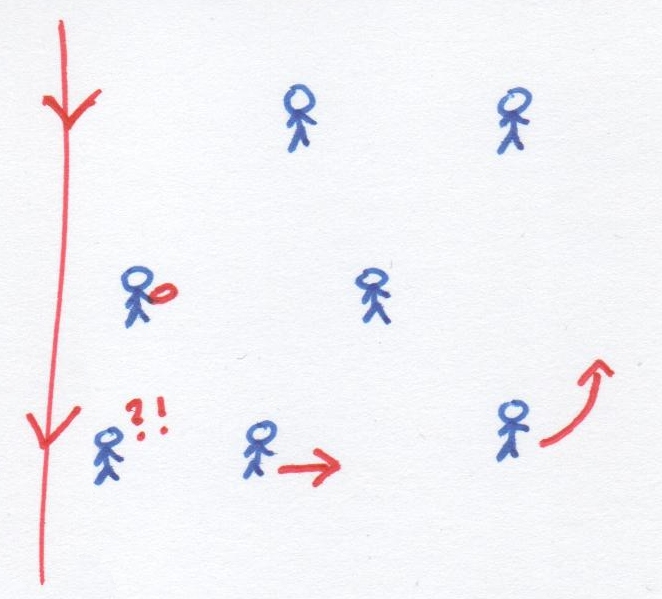
and then set up their shape correctly before continuing.
Some common scenarios which occur:
Over-rotation – a player gets trapped against the sideline, and they cannot find the solution. Caused by too many players pushing downfield, distorting the shape. Solution: communicate – rotate the shape.
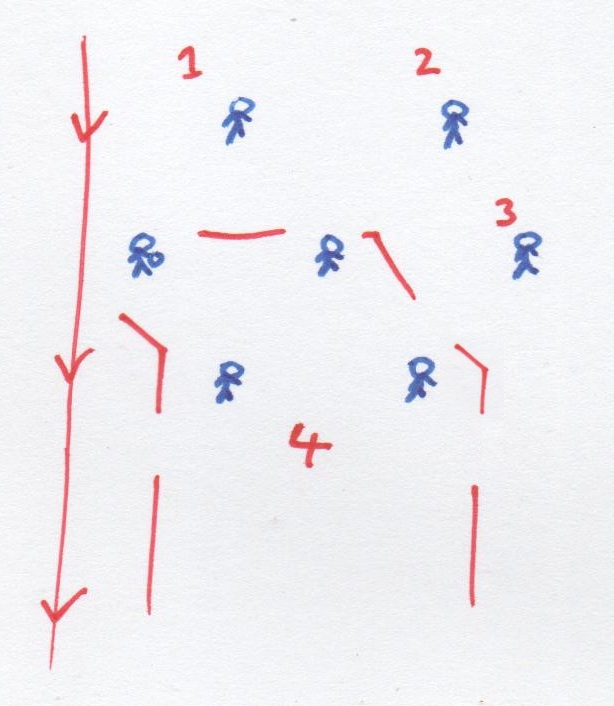 When you pass forward and to the line from a back position, you are already in a good position so don’t need to ‘clear’ downfield unless you know connected players wish to replace you. Many players have a habit of doing this, which can leave the ‘back’ positions vacant when the disc is on the sideline.
When you pass forward and to the line from a back position, you are already in a good position so don’t need to ‘clear’ downfield unless you know connected players wish to replace you. Many players have a habit of doing this, which can leave the ‘back’ positions vacant when the disc is on the sideline.
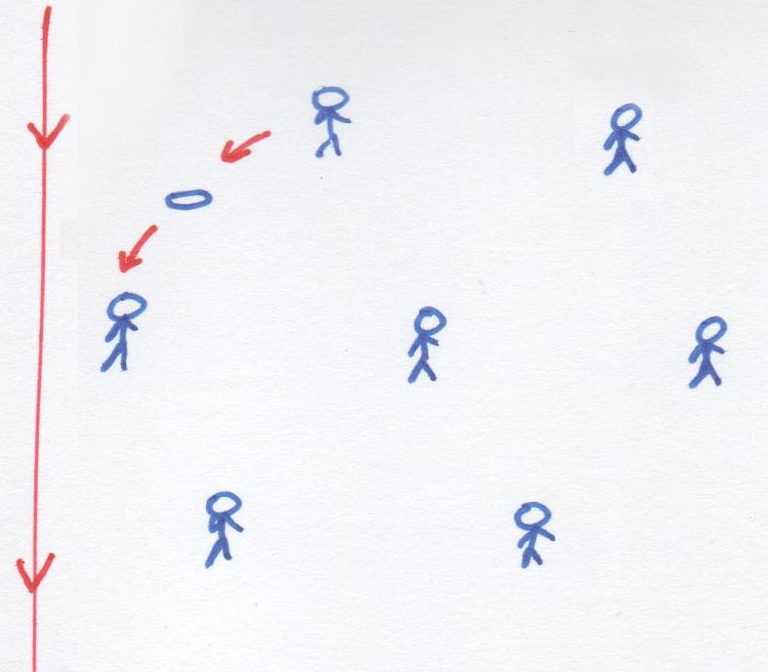
In the diagram on the left, positions 1 / 2 / 3 are important for sustaining possession and initiating flow, however most players will gravitate to area 4 out of habit, or out of an over-desire to score.
One way of fixing this flow-breaking problem is to use a whistle to stop the game when the disc is on the sideline, and check with the players how many of the back / far wing positions are occupied or vacant, and how long it takes them to move to occupy them. When they are occupied it should be clear how many more options are available to both the thrower and the cutters.
Further Learning
Live-Streamed Analysis Sessions
![]()
If you have done a few Hex trainings and would like to progress your team’s development, a live-streamed analysis session is ideal. The only requirement is good footage of your team training or playing Hex. A live-streamed analysis session involves your team following a YouTube link at a specific time/day, and joining Felix live as he goes through pre-recorded footage of your team playing and provides strategic, tactical, and technical analysis, with focus on particular areas the captain/coaches want to look at. Your team (of any number) can chat to each other, interact, and ask Felix questions in real-time via the Live Chat window. If this is still unclear, check out this example recording of a live streamed analysis session with Outbreak Mountain from Australia. There are a number of different Live-Streamed Analysis Session packages available depending on the needs of your team – get in touch with Felix for more details.
Hex Clinics
If you would like to kick-start Hex in your club then you should arrange a Hex Clinic for your city. This is the best way for your whole team to get on the same page with adopting Hex Offence (and Flex Defence, if you choose the full-weekend option). It includes classroom (theory) sessions, practical sessions, and footage analysis sessions immediately after training – if you choose to invest in that option. Get in touch with Felix for more details and a quote!
Another method of teaching Hex which has also been experimented with is the Play Progression Method. This involves less talking and more playing, so it’s particularly useful on cold days, or with teams who are receptive to going outside their comfort zone to try something new without it really being explained. After a warm up, go immediately into Ultimate games, giving the players small focus points between each round:
2v2: Take the open pass. Players should take the open lateral pass whenever the defenders allow it, which will mean they will often be level with each other, rather than one thrower back and one cutter downfield. When а defender takes the lateral pass away, there is plenty of space for a lead pass downfield. As opposed to a cutter trying to get free of their mark downfield for a pass, the type of movement you want to encourage looks more like this:
Brighton City (White) penetrating, vs Brighton Legends (Black) at Regionals 2015.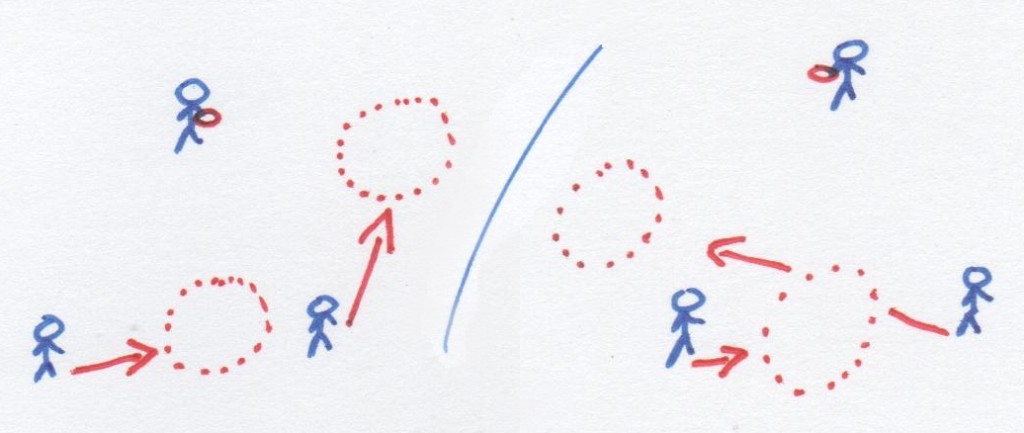
3v3: Stay connected without crowding – demonstrate what you mean by ‘connected’ (see ‘Explanation’ section on positions), and how it follows that a triangle setup is appropriate from a static disc. Demonstrate staying connected dynamically – if the other cutter cuts away from you, you should move towards them to stay connected, whereas if they cut towards/across you, you should either move away from them or towards where they came from, to avoid crowding.
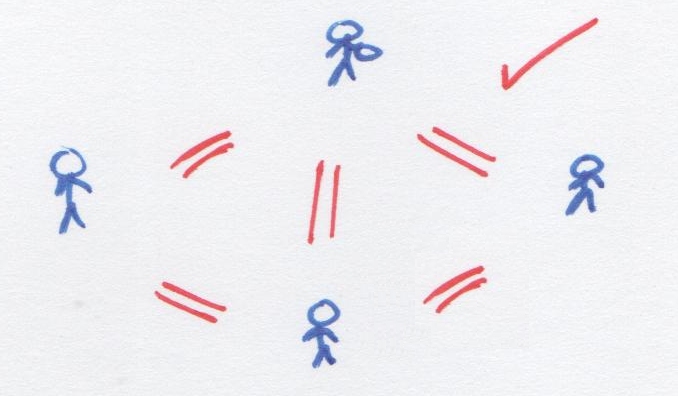 4v4: Make equilateral triangles – demonstrate the two possible shapes from a static disc, one where the thrower is part of two triangles, and another where the second triangle is further from the thrower, created by the downfield players. If in doubt, find two players and make an equilateral triangle with them.
4v4: Make equilateral triangles – demonstrate the two possible shapes from a static disc, one where the thrower is part of two triangles, and another where the second triangle is further from the thrower, created by the downfield players. If in doubt, find two players and make an equilateral triangle with them.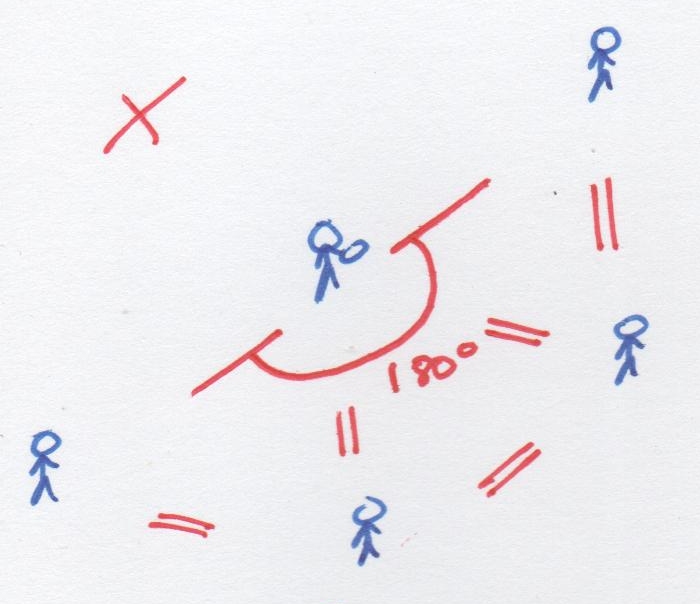
5v5 – 7v7: Don’t surround the disc – all players should be within the field of vision of the thrower – so only 3 players should be connected to the thrower.
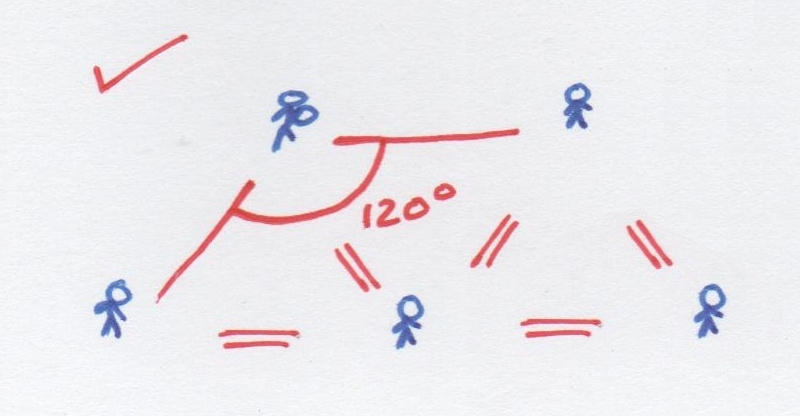 The remaining players should not set up connected to the disc, but should get connected to non-throwing players to make further triangles.
The remaining players should not set up connected to the disc, but should get connected to non-throwing players to make further triangles.
If too many players try to get connected to the thrower, the thrower becomes crowded and / or surrounded by defenders.
Extra Drills / Exercises
There are a number of drills which practice key elements of Hex offence. If players have had a go at Hex then they should be able to relate to the following drills / exercises:
Give-Go-Swill Drill
7-12 players
Focuses: Give-Go moves, Misdirection
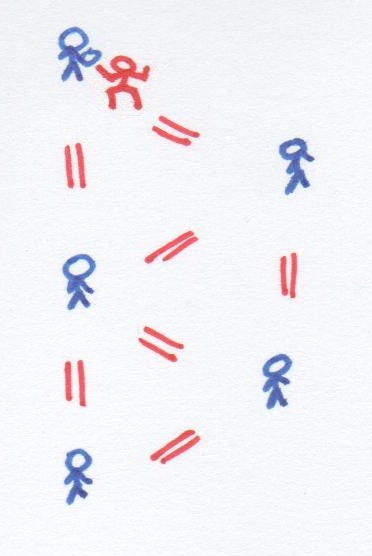 Players start as illustrated in the diagram on the left. The player at the top is the active ‘O’ player, accompanied by a defender – all other players are static. The active ‘O’ player is aiming to work the disc down to the player at the end of the drill, using at least one static player from the far side.
Players start as illustrated in the diagram on the left. The player at the top is the active ‘O’ player, accompanied by a defender – all other players are static. The active ‘O’ player is aiming to work the disc down to the player at the end of the drill, using at least one static player from the far side.
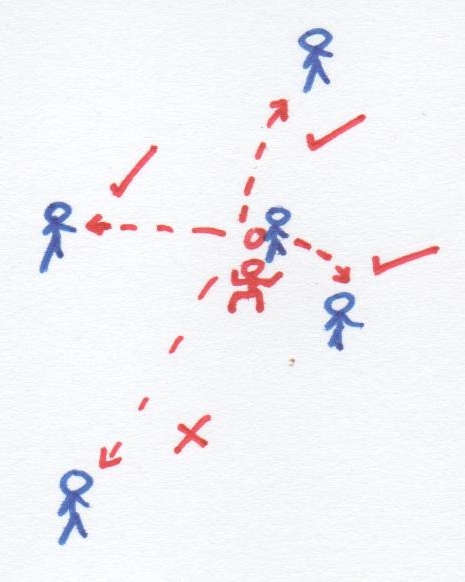 The offence is not allowed to throw to a player they are not connected to, and static players may not pass to each other.
The offence is not allowed to throw to a player they are not connected to, and static players may not pass to each other.
The defender is simply trying to stop the offensive player, by containing them / going for an interception / getting a point block. When the disc reaches the furthest player, they throw a long pass back to the start, swilly enough for both the O and the D to be able to make a bid for.
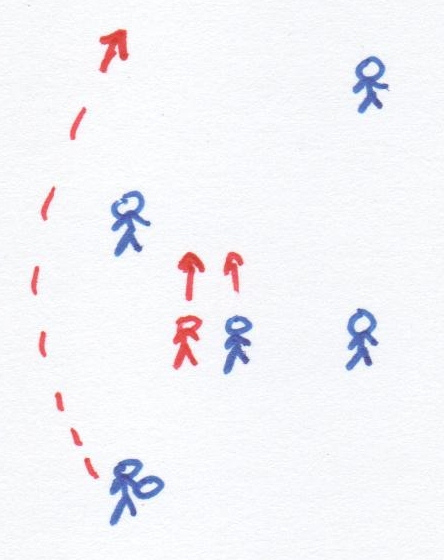 The give-go-swill drill trains misdirection, balance, and using flow and tempo to attack. Players should find that it is more effective to advance the disc through give-go moves – including moves away from the end target – than it is to directly break the force from static. Players also learn to communicate clearly with the static players about when/where they want the disc thrown back to them.
The give-go-swill drill trains misdirection, balance, and using flow and tempo to attack. Players should find that it is more effective to advance the disc through give-go moves – including moves away from the end target – than it is to directly break the force from static. Players also learn to communicate clearly with the static players about when/where they want the disc thrown back to them.
Rotation: The long thrower at the end joins the queue at the top, all the static players zig-zag down one position, the O becomes the first static player, and the defender becomes the active O player.
J-Lav running through the Give-Go-Swill drill at GB Mixed U23 2015 training
Mex Puzzle Drill
6-13 players
Focuses: Communication, Creating space
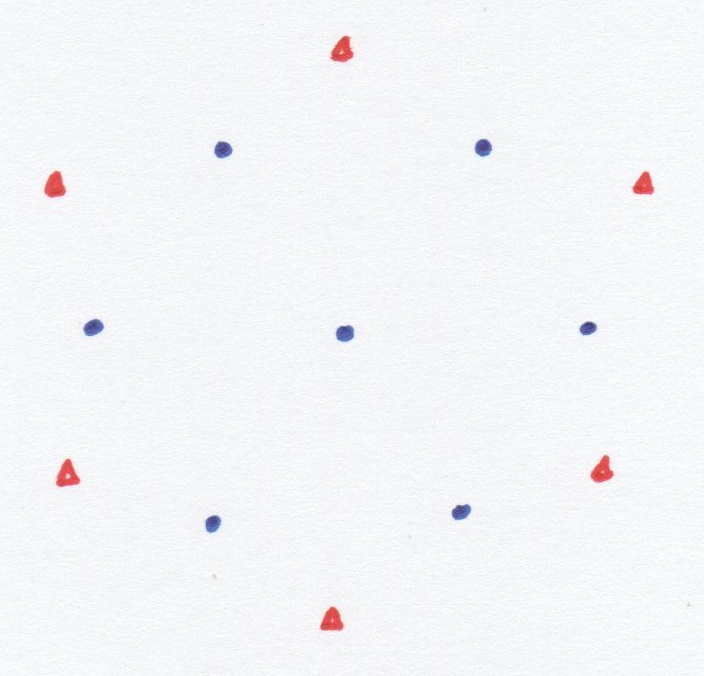 Set up 7 marker cones in a regular Hex formation, and add six ‘clearing cones’ around the outside, between the marker cones and further out from the centre. Players can cut to marker or clearing cones at any point and from anywhere in the formation, and they are allowed to hang out on the marker cones – but must continue moving if they are near a clearing cone. Passes should be made from marker cone to marker cone, hitting receivers in stride. The pass should be faked if a receiver arrives too early at a marker cone, if there are two cuts to the same cone, or if the thrower is not happy with making the pass for any other reason.
Set up 7 marker cones in a regular Hex formation, and add six ‘clearing cones’ around the outside, between the marker cones and further out from the centre. Players can cut to marker or clearing cones at any point and from anywhere in the formation, and they are allowed to hang out on the marker cones – but must continue moving if they are near a clearing cone. Passes should be made from marker cone to marker cone, hitting receivers in stride. The pass should be faked if a receiver arrives too early at a marker cone, if there are two cuts to the same cone, or if the thrower is not happy with making the pass for any other reason.
The disc starts on the edge of the formation, one player cuts to a clearing cone to create space for the first pass, and play continues for 30-60 seconds depending on your team. Players aim to keep flow by creating space for each other & keeping the disc moving. Fakes help the team keep tempo.
Mex Puzzle Drill is probably the hardest drill in the world which doesn’t involve defenders, and as such it can be frustrating – but it is great for teaching dynamic spatial awareness. Players constantly have their heads up, are looking to create space for each other and use it as they see it developing – a very valuable skill which is tricky to learn and tricky to teach.
In order to keep any kind of flow or tempo, the team must also learn to communicate constantly through vocalisation and gesticulation. This teaches them to work together as a team when playing offence, with everybody sharing the responsibility for keeping the disc alive.
Rotation: Mex Puzzle Drill can be very tiring, so regular breaks / multiple subs are recommended. Rolling subs can be waiting to be tagged in near the clearing cones, or the drill can be played in short bursts (although ideally the offence works at a rate they can sustain indefinitely).
Mex Puzzle Drill at Brighton City trials, 2015
Mex Huck Drill
8-13 players
Focus: Long throwing from motion, Breaking the force
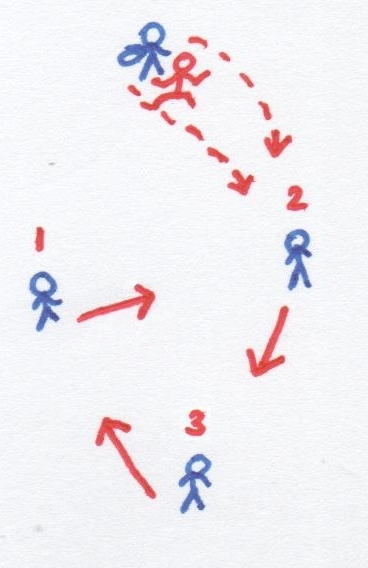 Players set up in a rhombus, first cut goes from the open to the break side, the other cutters follow the triangle rotation – break side player goes deep, deep/forward player comes under to the open side. If the break pass is thrown, the under cutter turns to go deep, and the deep cutter turns to come under.
Players set up in a rhombus, first cut goes from the open to the break side, the other cutters follow the triangle rotation – break side player goes deep, deep/forward player comes under to the open side. If the break pass is thrown, the under cutter turns to go deep, and the deep cutter turns to come under.
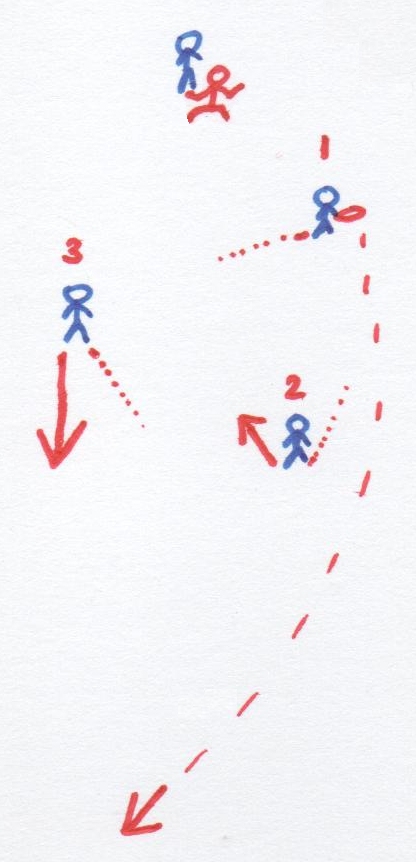 Catcher of the break pass throws long to the new deep cutter.
Catcher of the break pass throws long to the new deep cutter.
If the break pass is not thrown, cutters should improvise to provide a suitable backup option for the thrower – often the initial deep cutter is well placed / has good timing to come under for an open-side under pass, and then throw deep to the original break-side cutter.
If you want to expand on the Mex Huck Drill, consider adding defenders whilst also giving the cutters more freedom to choose the direction of rotation of the triangle. You can also change which cutter initiates the movement downfield – these modifications prevent players from simply ‘running through the motions’ – instead they should start with their hips facing the thrower, being ready to react to space as they see it being created. The setup/shape can also be rotated to create different angles – meaning the long thrower could receive the first pass moving towards as opposed to away from the end zone, or the disc movement could be changed to be lateral (a swinging drill) instead of downfield.
Rotation: New player becomes force, force becomes break-thrower, break-thrower becomes long thrower (starts open side), long thrower becomes deep-to-under cutter (starts deep), deep-to-under cutter becomes under-to-deep cutter (starts break side), under-to-deep cutter joins the queue.
| Mex Huck Drill at City trials 2015 | Variation – using open side if no break |
Flags
2-7 players
Focus: Identifying space, throwing skill
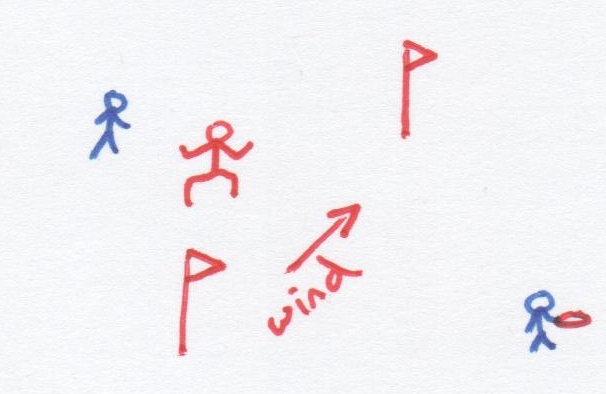 Flags is a simple game which adds training elements to a throw around. It will expose your weaknesses and challenge your strengths. Set out two flags (markers – water bottles are good) a few yards apart, one directly downwind of the other – these mark the goal line – the windier it is, the longer the goal line should be. The higher the skill of the players (and/or the lesser the wind), the narrower the goal line.
Flags is a simple game which adds training elements to a throw around. It will expose your weaknesses and challenge your strengths. Set out two flags (markers – water bottles are good) a few yards apart, one directly downwind of the other – these mark the goal line – the windier it is, the longer the goal line should be. The higher the skill of the players (and/or the lesser the wind), the narrower the goal line.
2 players: Throw from where you catch, don’t cut for throws but do move to catch them. (1) Throw over the goal line at any height, (2) Throw around the far side of the goal [OI], (3) Throw around the inside of the goal [IO]
3 players: 2v1 – Rolling defender, off-disc movement now encouraged. All players can move freely and pass on either side of the flags, but only passes across the goal line (at any height) count as goals. Goals reset a shot clock (7 seconds) – the shot clock can be counted by the defender from anywhere on the field, and if it runs out then it’s a turnover.
Experiment with different goal sizes, goal orientation to the wind, restricting the surrounding space with back lines, and so on. I recommend stalling from 3-10, as this is most game-like – mimicking the common situation where a thrower looks for a secondary option at stall 3.
Let me know if you come up with some interesting exercises, drills, games, or ultimate rule-modifications yourself! As it was written on the first frisbee – Play catch. Invent games. Have fun.
If you have any questions, just get in touch.
For videos of full games with Hexagon offence, check out the Hexagon Ultimate YouTube and Facebook pages.
Related:
Hexagon Ultimate YouTube
Hexagon Ultimate Facebook
Reddit discussion on (an old version of) this article


Alternative: Play progression method